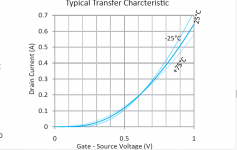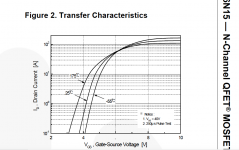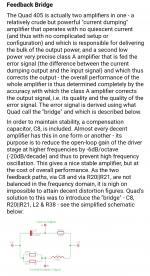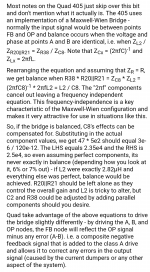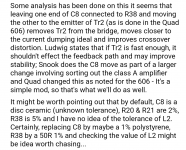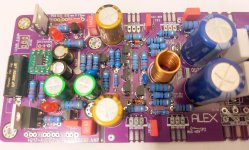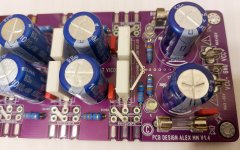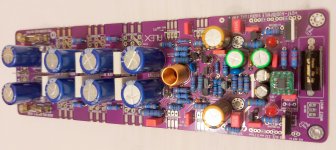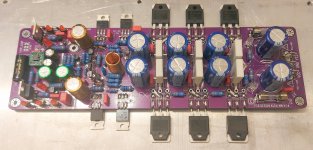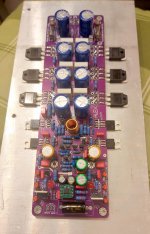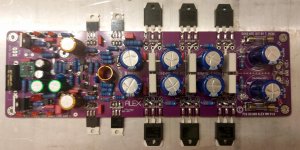Yes, laterals and verticals sound completely different and not by a small margin.
Electrically they behave different as well.
Laterals have negative temperature coefficient, means that are naturally immune to thermal runaway. They exhibit exceptional linearity at the cost of a small transconductance.
If you like a settled, smooth sound with less impact, than laterals are for you.
Verticals have positive temperature coefficient, means that they may exhibit thermal runaway and some design precautions must be taken.
I have attached transfer vs temperature for an Exicon duble die mosfet - left picture -, and transfer vs temperature for Firechild DMOS used in Q17 -right picture.
You may see that over Id~200mA the Exicon exhibit negative tempco. The Vgs increase with temperature. Meaning that Exicon drain current decrease with temperature. This is acting like a thermal protection.
On Firechild you can see that up to Id~60A, this exhibit positive temco. Drain current will increase with temperature. As you push hard the amplifier, stronger this will become. If you push over Id~60A, this will exhibit negative temco as well, but @60A most probably you are already far away and out of SOA. 😛
From sonic point of view, in our case, Q17 and class B operation, I prefer FQA DMOS from Firechild.
Regards,
Tibi
Electrically they behave different as well.
Laterals have negative temperature coefficient, means that are naturally immune to thermal runaway. They exhibit exceptional linearity at the cost of a small transconductance.
If you like a settled, smooth sound with less impact, than laterals are for you.
Verticals have positive temperature coefficient, means that they may exhibit thermal runaway and some design precautions must be taken.
I have attached transfer vs temperature for an Exicon duble die mosfet - left picture -, and transfer vs temperature for Firechild DMOS used in Q17 -right picture.
You may see that over Id~200mA the Exicon exhibit negative tempco. The Vgs increase with temperature. Meaning that Exicon drain current decrease with temperature. This is acting like a thermal protection.
On Firechild you can see that up to Id~60A, this exhibit positive temco. Drain current will increase with temperature. As you push hard the amplifier, stronger this will become. If you push over Id~60A, this will exhibit negative temco as well, but @60A most probably you are already far away and out of SOA. 😛
From sonic point of view, in our case, Q17 and class B operation, I prefer FQA DMOS from Firechild.
Regards,
Tibi
Attachments
Last edited by a moderator:
Plus , help to compute maths : how tot dimension value of Damping bridged if L =0.8 uH ?
Quad 405-2 upgrades
Quad 405-2 upgrades
Attachments
Keeping original QUAD405 values for bridge resistors (one is part of NFB) and for L=0.8uH, you get bridge capacitor 34pF. So you may go for standard 33pF and add a 5pF ceramic trimmer for fine tuning.
ZL2 / ZR20||R21 = ZR38 / ZC8
2πfL / 500 = 47 / (2πfC)-1
2πf x 0,8x10-6/ 500 = 47 / (2πfC)-1
2πf x 0,8x10-6/ 500 = 47 x 2πfC
2πf x 0,8x10-6/ 500 = 47 x 2πfC
C = 0,8x10-6/ (500 x 47)
C = 0,000034x10-6
C = 34pF
Regards,
Tibi
ZL2 / ZR20||R21 = ZR38 / ZC8
2πfL / 500 = 47 / (2πfC)-1
2πf x 0,8x10-6/ 500 = 47 / (2πfC)-1
2πf x 0,8x10-6/ 500 = 47 x 2πfC
2πf x 0,8x10-6/ 500 = 47 x 2πfC
C = 0,8x10-6/ (500 x 47)
C = 0,000034x10-6
C = 34pF
Regards,
Tibi
I have a question for Tibi: is there a difference in sound quality at low and medium levels between one pair and three pairs of verticals?
Thank you!
Thank you!
Hello, I assembled 2 amplifiers and I am pleasantly surprised by the sound quality, my only remark I have is that I have to slightly raise the treble by maybe 3 decibels to reach their desired sound. I can't complain about low - they are great. Does this only happen to me or has someone else noticed it ?? Note that the only difference from the circuit of Q17 are the transistors Q9 and Q11. It was not available in Farnell and Mouser and for that I used TP0606N3-G, which is close to the parameters of BS250.
Hello 208,
I don't use a bs250 either and I also installed sockets for transistors in one of the test versions I set up to check whether different transistors sound the same.
Therefore I assume that you have installed an unsuitable C7. I had a very good MKP at first and had to realise that it was not enough. So I installed tin foil KP and it sounds excellent.
I don't use a bs250 either and I also installed sockets for transistors in one of the test versions I set up to check whether different transistors sound the same.
Therefore I assume that you have installed an unsuitable C7. I had a very good MKP at first and had to realise that it was not enough. So I installed tin foil KP and it sounds excellent.
I have a question for Tibi: is there a difference in sound quality at low and medium levels between one pair and three pairs of verticals?
Thank you!
Yes, it is.
As you add more pairs, output impedance drop and even at low levels the performance can be very audible. Speakers make a huge difference here.
Regards,
Tibi
Last edited by a moderator:
@http208,
TP0606N3-G are ok. Give them a serious burn-in, or you may change them for a bipolar mirror.
Other parts count too. Power supply as well ... etc.
Regards,
Tibi
TP0606N3-G are ok. Give them a serious burn-in, or you may change them for a bipolar mirror.
Other parts count too. Power supply as well ... etc.
Regards,
Tibi
Hello Alex,
It looks beautiful.
Is your first variant already playing?
Have you been able to hear your 1st setup with a pair of power transistors yet?
It looks beautiful.
Is your first variant already playing?
Have you been able to hear your 1st setup with a pair of power transistors yet?
Thanks for the help.
I bought not very expensive capacitors just for a sample
to feel the difference and really it is. With a better capacitor, the sound is more real and normal. I have currently put on a Mundorf MCap 250. however, I want to try the Mundorf ZN 630, but here I was slightly shocked by the price of 19 euros. Will the sound change and how? ... If anyone has an idea and can offer me something better.
After I began on this topic, I tried the effect of changing C2. With a good capacitor as in the sheme
the sound is quite "ordinary" and a bit flat. With two electrolytic capacitors of 220uf connected in series, the sound changes - it becomes more voluminous, softer and more spacious. At least that's how it seemed to me.Does anyone have an opinion on the matter?
I bought not very expensive capacitors just for a sample
to feel the difference and really it is. With a better capacitor, the sound is more real and normal. I have currently put on a Mundorf MCap 250. however, I want to try the Mundorf ZN 630, but here I was slightly shocked by the price of 19 euros. Will the sound change and how? ... If anyone has an idea and can offer me something better.
After I began on this topic, I tried the effect of changing C2. With a good capacitor as in the sheme
the sound is quite "ordinary" and a bit flat. With two electrolytic capacitors of 220uf connected in series, the sound changes - it becomes more voluminous, softer and more spacious. At least that's how it seemed to me.Does anyone have an opinion on the matter?
Mundorf ZN and Audyn KPSN are the same capacitors. With this type of capacitor, there are no differences in sound with different dielectric strength (volt number), as is the case with MKP. I buy Audyn KPSN in the Netherlands, where it is cheaper than at intertechnik.
I think that these capacitors offer the highest resolution. But I don't know the potential of paper oil capacitors, they also cost many times more, but these could also play very well.
I think that these capacitors offer the highest resolution. But I don't know the potential of paper oil capacitors, they also cost many times more, but these could also play very well.
The 0.22 uF kpsn or Mundorf ZN is a good and cheep. A capacitor like this as a bypass to the 1uF Mcap is also a pretty good solution.Thanks for the help.
I bought not very expensive capacitors just for a sample
to feel the difference and really it is. With a better capacitor, the sound is more real and normal. I have currently put on a Mundorf MCap 250. however, I want to try the Mundorf ZN 630, but here I was slightly shocked by the price of 19 euros. Will the sound change and how? ... If anyone has an idea and can offer me something better.
With this type of capacitor, there are no differences in sound with different dielectric strength (volt number), as is the case with MKP.
This is interesting, but for me inexplicable. The dielectric is the same, right?
With normal MKP, I have a vapourised polypropylene film, which needs a thicker metal thickness for higher impulses. Since these vapour depositions are very thin, the ohmic resistance naturally changes with the thickness of the metal layer.
With the KP capacitors, I have a polypropylene film and a metal film, in this case high-purity tin, which, as far as I know, is only produced by one manufacturer worldwide. This tin foil is the same for all ZN KP, regardless of whether it says Mundorf or Audyn on it. The capacitors differ in the polypropylene foil, here a thin one is rather advantageous for a high specific mass of the capacitor to minimise mechanical movement by the electrostatic electric fields, which do not build up as symmetrically as in the model of the ideal capacitor. With this consideration, it can be seen that a ZN KP is more likely to have a low dielectric strength for maximum audiophile experience, while a MKP is more likely to have a high dielectric strength or impulse strength. Therefore, it is not surprising what can be read in wima's data sheets on MKP and FKP.
With the KP capacitors, I have a polypropylene film and a metal film, in this case high-purity tin, which, as far as I know, is only produced by one manufacturer worldwide. This tin foil is the same for all ZN KP, regardless of whether it says Mundorf or Audyn on it. The capacitors differ in the polypropylene foil, here a thin one is rather advantageous for a high specific mass of the capacitor to minimise mechanical movement by the electrostatic electric fields, which do not build up as symmetrically as in the model of the ideal capacitor. With this consideration, it can be seen that a ZN KP is more likely to have a low dielectric strength for maximum audiophile experience, while a MKP is more likely to have a high dielectric strength or impulse strength. Therefore, it is not surprising what can be read in wima's data sheets on MKP and FKP.
Last edited:
I like your boards Alex, but I'm eagerly waiting to hear your impression about sound.
Regards,
Tibi
Regards,
Tibi
Hello Alex,
It looks beautiful.
Is your first variant already playing?
Have you been able to hear your 1st setup with a pair of power transistors yet?
Hi Tim,
Neither the first nor the second variant was tested, I work slower when I have time and materials. 🙂
Attachments
- Home
- Amplifiers
- Solid State
- Q17 - an audiophile approach to perfect sound
